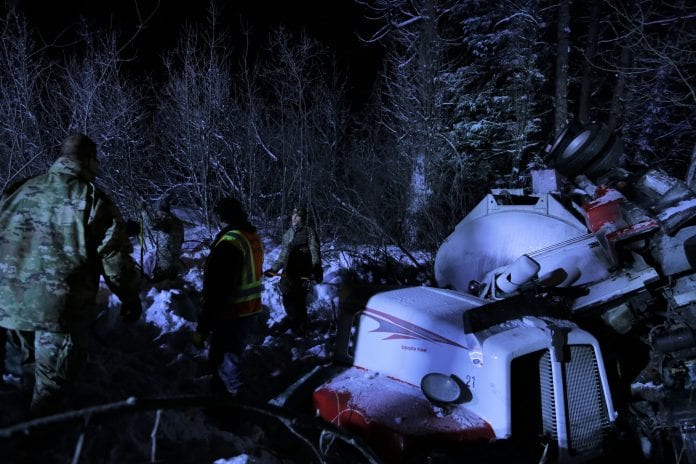
National Guard troops in Valdez for training were called into action in late February to assist the Valdez Fire Department in containing a fuel spill from a tanker truck that crashed near a waterway and began spilling diesel fuel from a ruptured tank.
Teams from the Alaska National Guard and Washington National Guard Homeland Response Force pitched in with first responders, digging trenches and laying down chemical quick dry to keep the fuel from reaching a fresh water stream used for fishing, according to the Alaska Department of Military and Veterans Affairs. Tests were conducted in water samples and no chemical substance was detected in the stream.
The guardsmen were in Valdez on Feb. 22 for Arctic Eagle 2018, a statewide exercise involving national, state and local agencies designed to provide opportunities for 1,100 participants to conduct sustained operations in arctic conditions.
The Alaska Department of Environmental Conservation said an estimated 2,500 gallons of fuel was spilled and another 7,200 gallons was lightered from the vehicle.
The spill occurred on frozen ground with a large snow pack off the side of the road, DEC officials said. The Robe River, directly west of the spill, did not appear to be impacted.
As of Feb. 26, cleanup contractors were on site to remove contaminated snow and soil, and store it in lined containment cells, DEC officials said. Some 10,000 gallons of contaminated groundwater had been collected by vac-trucks for separation and absorbent boom placed in several locations along a tributary to the Robe River, which was being monitored.
Arctic Eagle 2018 includes scenario-based events at multiple locations throughout Alaska. These include hazardous material detection and response, security and protection of critical infrastructure, triage, domain awareness patrol, communication and transportation support.
The overall goal is for participants to operate in a joint interagency, intergovernmental and multinational environment, while assessing their ability to conduct sustained operations in arctic conditions, and integrate new and emerging capabilities, said state military officials.
The 103rd Civil Support Team, Alaska National Guard, is a joint 22-person unit that supports local and state authorities with incident site analysis, response measures and assists with requests for additional military support.
The Washington National Guard, FEMA Region X, Homeland Response Force, is a regionally aligned chemical, biological, radiological, nuclear, high yield explosive asset established to support and enhance local, state and federal emergency managers in response to natural or man-made disasters.














